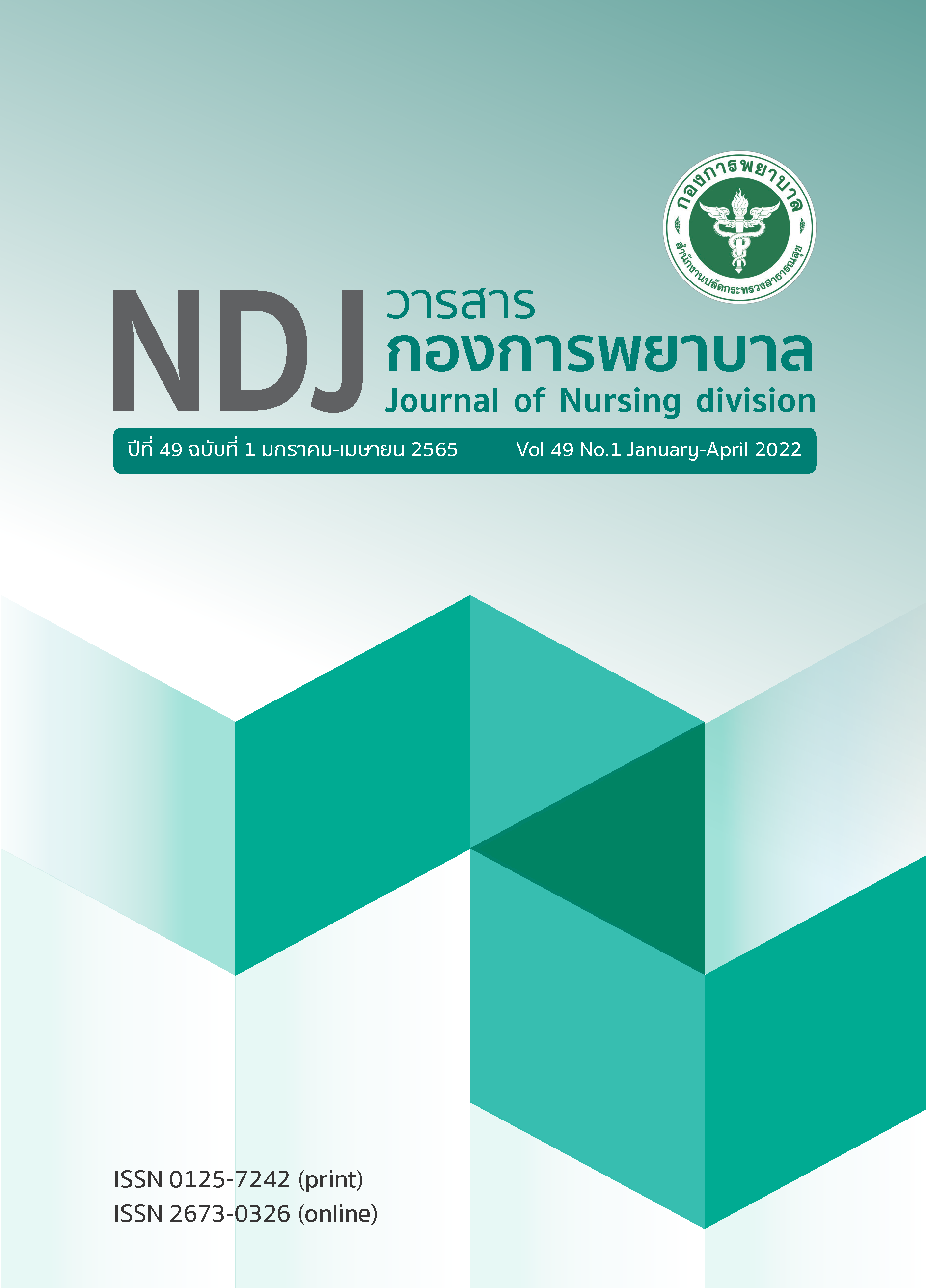การพัฒนาแนวปฏิบัติการพยาบาลในการหย่าเครื่องช่วยหายใจในผู้ป่วยผ่าตัดสมอง หอผู้ป่วยวิกฤตศัลยกรรม โรงพยาบาลเลย
Main Article Content
บทคัดย่อ
การวิจัยและพัฒนานี้มีวัตถุประสงค์เพื่อพัฒนาแนวปฏิบัติการพยาบาลในการหย่าเครื่องช่วยหายใจในผู้ป่วยผ่าตัดสมองและประเมินผลลัพธ์การใช้แนวปฏิบัติ ดำเนินการ 4 ระยะคือ (1) การค้นหาปัญหาทางคลินิก (2) การสืบค้นหลักฐานเชิงประจักษ์เพื่อพัฒนาแนวปฏิบัติ (3) การนำแนวปฏิบัติไปทดลองใช้ และ (4) การนำแนวปฏิบัติที่ปรับปรุงแล้วไปใช้จริงในหน่วยงาน กลุ่มตัวอย่างเลือกแบบเจาะจง ประกอบด้วย (1) ผู้ป่วยผ่าตัดสมองที่หย่าเครื่องช่วยหายใจ จำนวน 12 ราย (2) พยาบาลวิชาชีพที่ปฏิบัติงานในหอผู้ป่วยวิกฤตศัลยกรรม โรงพยาบาลเลย จำนวน 16 ราย ดำเนินการวิจัยตั้งแต่เดือนธันวาคม พ.ศ. 2563 ถึงเดือนเมษายน พ.ศ. 2564 วิเคราะห์ข้อมูลเชิงปริมาณด้วยร้อยละ ค่าเฉลี่ย และส่วนเบี่ยงเบนมาตรฐาน วิเคราะห์ข้อมูลเชิงคุณภาพ โดยการวิเคราะห์เนื้อหา
ผลการค้นหาปัญหาทางคลินิก พบว่า แนวปฏิบัติการพยาบาลในการหย่าเครื่องช่วยหายใจที่ใช้อยู่ไม่เหมาะสมกับผู้ป่วยผ่าตัดสมอง นำไปสู่การสืบค้นหลักฐานเชิงประจักษ์เพื่อพัฒนาแนวปฏิบัติการพยาบาลในการหย่าเครื่องช่วยหายใจในผู้ป่วยผ่าตัดสมอง ผลการนำแนวปฏิบัติไปทดลองใช้ในผู้ป่วยผ่าตัดสมอง จำนวน 5 ราย พบว่า ผู้ป่วยหย่าเครื่องช่วยหายใจได้สำเร็จ ร้อยละ 100 และผลการนำแนวปฏิบัติที่ปรับปรุงแล้วไปใช้จริงพบว่า ผู้ป่วยผ่าตัดสมองจำนวน 12 ราย มีความสำเร็จในการหย่าเครื่องช่วยหายใจร้อยละ 100 มีระยะเวลาในการใช้เครื่องช่วยหายใจเฉลี่ย 6.7 วัน (SD + 9.1) และพยาบาลวิชาชีพมีความพึงพอใจในการใช้แนวปฏิบัติการพยาบาลในการหย่าเครื่องช่วยหายใจร้อยละ 100
Article Details

อนุญาตภายใต้เงื่อนไข Creative Commons Attribution-NonCommercial-NoDerivatives 4.0 International License.
เอกสารอ้างอิง
KamthornTantivitayatan. The clinical guideline of weaning from mechanical ventilation, In: YongyuthKajornpredanon, eds. Themedical equipment of intensive care unit; 2015:551-60. Thai.
SarathgonthThanajronpath,UsaWonganan,ChirunjaKanchanabothsaya, SasitornSirikul, UsaKlinkajorn.The development of program and the effectiveness of weaning ventilator protocol on success of weaning and duration of mechanical ventilator in patients with traumatic braininjury.Journal of Nursing and Health Care. 2015;33(2):83-90. Thai.
Metacalf AY, Stoller JK, Fry TD,HabermannM. Pattern and factors associated with respiratory care protocol use. Respir Care.2015;60(5):636-43.
Girard TD, Alhazzani W, Kress JP,et al.Anofficial American thoracic society/American college of chest physicians clinical practice guideline: Liberation from mechanical ventilation in critical ill adults. Am J RespirCrit Care Med.2017;195:120-33.
Withers A, Man TC,D’CruzR, et at. Highlights from the respiratory failure and mechanicalventilation 2020 Conference. ERJ open research. 2021;7(1):1-13.
Outlet DR, Patel S, Girard TD, et al. Liberation from mechanical ventilation: An official American thoracic society/American college of chest physicians clinical practice guideline. Chest.2017;151:166-80.
Aslani Y, Niknejad R, Moghimian M, Maghaddasi J,Akbari M. An investigation of the psychological experiences of patients undermechanical ventilation following open heart surgery. ARYA Atherosclerosis.2017;13(6):274-81.
TarntipWisettharn, KunjanaPukkharm,SomjitYodrabum. The development of ventilator weaning model in critical ill surgical patients inMaharaj Nakhorn Si Thammarat hospital. Journal of Cardio-Thoracic Nursing. 2019; 30(2):176-92. Thai.
Li Y, Li H,Zhang D. Comparison of T-piece and pressure support ventilation as spontaneous breathing trials in critically ill patients: a systematic review and meta-analysis. Crit Care. 2020;24(1):67.
Koutsoukou A, Katsiari M, Orfanos SE, et al. Respiratory mechanics in brain injury: A review. World JCritCare Med.2016;5(1):65-73.
The medication record of Loei hospital. [Medical record]. Loei hospital; 2019.
CinottiR, Bouras M, Roquilly A,Asehnoune K. Management and weaning from mechanical ventilation in neurologic patients. Ann TranslMed. 2018;6(19):381.
Boles JM, Bion J, Connors A, et al. Weaning from mechanicalventilation. Eur Clin Respir J.2007;29(5):1033-56.
Soukup SM.The center for Advanced Nursing Practice evidence-based practice model: promoting the scholarship ofpractice. Nurs Clin North Am.2000;35(2):301-9.
Joanna Briggs Institute. The JBI Levels of evidence. [Internet]. 2014 [cited 2022 Mar 4]; [5 screens]. Available from: URL:https://ospguides.ovid.com/OSPguides/jbidb.htm
Perkins GD, Mistry D, Gates S, et al. Effect of protocolized weaning with early extubation toNoninvasive ventilation vs invasive weaning on time to liberations with respiratory failure the breath randomized clinical trial.JAMA. 2018;320(18):1881-8.
Patsaki I, Christakou A, Papadopoulos E, et al. The combination of inspiratory muscle training and high flow nasal cannula oxygen therapy for promoting weaning outcomes in difficult- to-wean patients: protocolfor randomized controled trial. ERJ open research. 2020;6:00088-2020.
YoriyaE, PinyokamN,TachaudomdachC. Factor rate related to critical care nurse’ practices reguardingweaning from mechanical. Nursing Journal.2020;47(3):133-45.
GunyanatPongpaew,SommaiKhotchanam. The professional nurses’ competencies in caring management of patients with mechanicalventilator at NopparatRajathanee hospital.Vajira Nursing Journal. 2018;20(2):1-12. Thai.
Knebel AR, Shekleton ME, Burns S, Clochesy JM, Hanneman SK. Weaning from mechanical ventilation
support: refinement of a model. AmJ Crit Care. 1998;7(2):149-52.
JiranuwatChansungnoen, NuntayaSanee,WaraneeSumrit, JaruneeJantaraduek, PramjaiJantara, InghathaiDamchut. Promoting clinical nursing practice guideline on mechanical ventilation program on incidence of ventilator associated-pneumonia among head injured patients.Hua Hin Medical Journal. 2021;1(1):1-10. Thai.
Vetrugno L, Guadagnin GM, Brussa A, et al. Mechanical ventilation weaning issues can be counted on the fingers of just one hand: pate 1. Ultrasound J. 2022;12(9).


